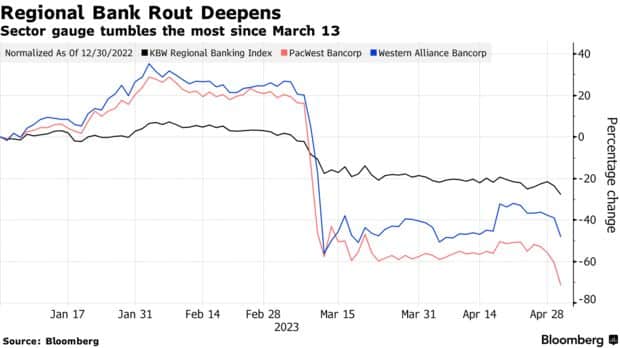PacWest Bancorp and Western Alliance Bancorp led a deep selloff in regional lenders Tuesday, as renewed fears over the health of the financial system hit Wall Street after the second-largest US bank failure ever.
Trading in both firms triggered multiple volatility halts as PacWest fell 28% to close at a record low while Western Alliance tumbled 15%. The pair has shed more than $5 billion in market value so far this year. The KBW Regional Banking Index dropped 5.5% on Tuesday, the most since the crisis that engulfed Silicon Valley Bank in March.
Charles Schwab Corp., a brokerage with a banking arm that’s come under pressure in the recent rout, fell 3.3% amid the broader selloff in financial stocks. Comerica Inc. and Zions Bancorp. each tumbled more than 10% while Metropolitan Bank Holding Corp. dropped 20%.
The turmoil comes a day after JPMorgan Chase & Co.’s Jamie Dimon said the current banking crisis is nearing its end after his bank’s purchase of First Republic, though he acknowledged it’s possible another small lender could fail. The regional bank gauge is already down 28% so far this year.
“The resolution of First Republic helps to ease concerns but not eliminate them,” Wells Fargo & Co. analyst Mike Mayo said in an interview. “A triple dose of negative sentiment is impacting the regionals: commercial real estate, diversification and regulation.”
Western Alliance and PacWest are among a number of regional banks that investors have zeroed in on after the collapse of Silvergate Capital Corp., SVB Financial Group’s Silicon Valley Bank, and Signature Bank in March. The turmoil demonstrated the threat posed to commercial lenders by asset-liability mismatches and uninsured deposits.
Still, both Western Alliance and PacWest posted earnings results in April that appeared to appease investors, while indicating their deposit bases had stabilized or recovered after initial outflows in March.
“Wall Street is wondering which bank could be the next one that needs a rescue and that is making it easy to pick on the other regional banks,” said Edward Moya, Oanda senior market analyst. “It looks like JPMorgan’s deal for FRC gave us one day of calm for the banking sector. Regional banking stocks are still looking vulnerable until we see clear signs that emergency lending programs can go away.”

RBC Capital Markets analyst Jon Arfstrom wrote that the Tuesday swings in the regional bank stocks were unusual and his conversations with investors didn’t indicate any new concerns. He recommended buying the dips in stocks including Comerica, PacWest and Western Alliance.
“In our view, unwarranted negative sentiment is continuing to drive elevated moves in these stocks,” the analyst wrote. “Our sense is that today’s action is an amplification of ongoing fears as the market looks to digest the implications of the First Republic resolution and an overall more challenging longer term profitability outlook for the industry.”
Part of what’s driving bank shares down is the fact that many regional bank investors assumed the Federal Deposit Insurance Corp. would announce a change to deposit insurance alongside its announcements about the First Republic receivership process, said Gary Tenner, an analyst at DA Davidson. The level of uninsured deposits at Silicon Valley Bank and Signature played a key role in the bank runs that led to their downfall.
“A lot of banks were recovering deposits or growing deposits at this point,” Tenner said in a telephone interview. “This is not fundamentally driven. It’s more pressure on names now that there was no clear change in the deposit insurance.”
Speaking Tuesday at the Milken Institute Global Conference, Wells Fargo & Co. Chief Executive Officer Charlie Scharf said that regulators functioned as they were supposed to in the recent turmoil. He said the majority of banks his firm is monitoring are “strong.”
Regulatory Response
While idiosyncratic factors are at play in the recent collapse of regional lenders, their troubles can be traced back to higher interest rates — raising their cost of funding while eroding the value of assets. As deposits have left the system for higher-returning vehicles like money-market funds, banks have loaded up on liquidity provided by the Federal Reserve and the Federal Home Loan Bank system. Those funds have kept banks liquid, but the high cost of funding is set to hurt profitability.
“While FRC resolution is a good sign, we haven’t had a clear solution to the lack of confidence across regional banks and may need a more holistic response from regulators or the government,” Bloomberg Intelligence analyst Herman Chan said in a message.
Investors will start to take a “pretty hard” look at banks that have “bellied up to the Fed and the FLHB,” said Abbott Cooper, an activist investor who worked on deals for failed banks during the Global Financial Crisis.
— By Max Reyes and Breanna Bradham with assistance by Jennifer Surane and Hannah Levitt (Bloomberg)









